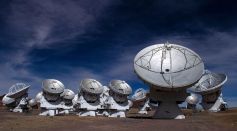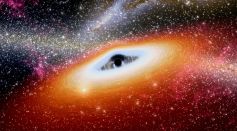Tags: Magnetic field
Red Dwarf Star AD Leonis May Be Approaching Polar Reversal, Provides Insight on the Evolution of Solar Magnetic Field
Iron Atoms Found Moving Inside the Earth’s Solid Inner Core, Affecting the Magnetic Field With Their Collective Motion

ALMA Reveals Ancient Galaxy's Magnetic Field, Shedding Light on Cosmic Magnetism
Powerful Magnetic Fields of Cool Stars Could Render Exoplanets Uninhabitable, Study Reveals
Intriguing 'Ultracool' Star Emits Radio Waves Despite Having a Weak Magnetic Field, Challenging Astrophysical Norms
Exoplanet Wasp-18 B Has Strong Magnetic Field, Shows Signs of Water Vapor [Study]

Origin of Mystery Fast Radio Burst Revealed Thanks to Highly Changeable Magnetic Field Surrounding It
New 3D Map of Local Bubble Reveals Its Magnetic Field Structure That Will Help Examine Superbubbles in Novel Ways

European Space Agency Released Haunting Audio of Earth's Magnetic Field [LISTEN]
Significant Magnetic Field Shift Occurred in the San Andreas Magnetic Field Prior to an Earthquake [STUDY]

Scientists Look for More Molecular Magnets for Improving Spin Electronics and Quantum-Scale Computing

Magnetic Nanoparticles Can Be Triggered to Release Therapeutic microRNA to Targeted Cancer Cells for Treatment

Massive Black Hole May Have Done a 180-Degree Magnetic Flip in A 'Strange Explosive Episode'

Mysterious Rumbling Noise on Mars Sparks Hope for Finding Signs of Life on the Red Planet

Geomagnetic Storms Detected in Mercury Despite Weaker Magnetic Field; How Do They Compare to Earth's?

Geomagnetic Storm Effects: What Happens To Earth When a Huge Solar Storm Like the 1859 Carrington Event Occurs?

Earth's Magnetic Field Help Migratory Birds Know Which Direction to Head and How to Return to Nesting Sites

European Migratory Songbirds Navigate with Magnetic Stop Signs

Spooky Cosmic Object Could Be A New Type of Star With Ultra-Powerful Magnetic Field

What Will Happen If Earth Stops Spinning in Its Orbit?
Most Popular

Largest Known Volcanic Aquifer Discovered Beneath Oregon's Cascades

New 'Supergiant' Sea Bug Found in South China Sea, Named After Darth Vader

Mediterranean Sea Was Refilled by a Catastrophic Flood Millions of Years Ago

Mysterious Cosmic Waves That Sound Like Birds Detected in Unexpected Space Region




